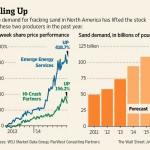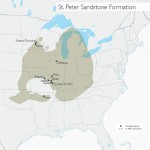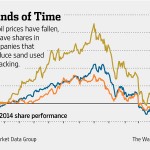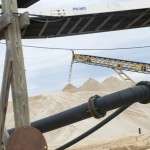Why The Stock Market Casino Is Dangerous: The Case Of Looney …
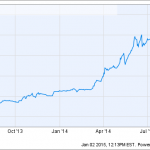
On August 4th the Wall Street Journal carried a breathless tale of how a handful of obscure oilfield suppliers were striking immense riches in the sand dunes of Wisconsin. Owing to the “shale revolution”, the stock price of an outfit that had originated in the stagnating business of supplying sand traps to golf courses, and which had been at death’s door as recently as 2011, had gone parabolic.
Emerge Energy Services (EMES) presently traded at $145 per share, reflecting a red hot gain of 8.5X over its $17 IPO price fifteen months earlier. In a literal sense, silicon valley had come to the silicon dunes of Lake Michigan, as reflected in EMES’ valuation at 43X its LTM earnings.
Given the fact that EMES’ share price had most recently risen by $100 or $2.5 billion of market cap just since January 2014, the “momo” story was self-evidently all about upside growth, not current profits or cash flow. In fact, during its 14 quarters as a public filer, EMES had generated negative $50 million of operating cash flow after CapEx. So at a total enterprise value of $3.7 billion, the punters chasing the stock straight up the parabolic curve would seemingly have anticipated some stupendous growth indeed.
Except……except they had no idea about EMES’ sustainable growth potential and didn’t care because the buyers were robots, day traders and flavor-of-the-month hedge funds. They were piling into the stock of a company selling a form (white sand) of the second most abundant low-value commodity on planet earth for no other reason than Emerge Energy Services was another momo play on steroids. The “price action” was the investment thesis.
Yet this typical momo “rip” had occurred not out of the natural elements of human greed and capitalist enterprise, but because the stock market has been destroyed by the Fed. That is, the combination of ZIRP and wealth effects “puts” have eviscerated all of the checks and balances that contain and modulate speculation in honest free markets.
On the one hand, Fed policy has massively subsidized momo speculators in two powerful ways. First, most of them operate through the options markets or employ other forms of heavy, short-term position leverage.
Accordingly, their “carry” cost is close to zero, and their position leverage can be continuously rolled-over without risk. That’s because the Fed’s foolish commitment to “transparency” in pegging its policy rate means that speculators are in the catbird seat.
In effect, the Fed is committed to sending its interest rate change messages by pony express to speculators who operate in the nano-second based cybersphere of modern trading technology. It’s not even a contest; its a bad joke which showers the 1% with stupendous windfalls.
Secondly, even the friskiest day traders who intend to survive need to take out market insurance against their momo bets. That is, they buy puts on the S&P 500 to protect against a market wide downdraft.
Yet owing to the Fed’s drastic financial repression and market manipulation, this downside insurance is dirt cheap—meaning that the net returns on momo-chasing are inordinately high due to the Fed’s implicit subsidy of their cost of doing business (i.e. hedging). Supernormal returns, in turn, attract ever greater sums of speculative capital, thereby providing even greater buying power to the momo trades.
There is no secret as to why downside insurance is so heavily subsidized by the central banking branch of the state and is therefore so cheaply available to speculators. The absurd doctrine of “wealth effects” and the implicit Greenspan/Bernanke/Yellen “put” has generated a toxic deformation in the risk asset markets. Namely, the “buy-the-dips” reflex which has purged volatility from the broad market index almost entirely.
The pattern below would never occur in a honest free market. Nearly six straight years of continuous vertical lift just wouldn’t happen in a setting where the GDP of the underlying economy—US and Europe—-has grown virtually not at all since 2007 pre-crisis level, and where earnings are facing massive headwinds from global cooling, deflation and the heavy anchor of “peak debt”.
But the worst of the market wrecking deformations attributable to Keynesian central banking is not simply the massive implicit subsidies to financial gamblers. Of even greater significance is the fact that no financial market can be healthy and balanced without an abundance of well-capitalized short-sellers. Yet the impact of financial repression has been the utter destruction of whatever short-sellers remained at the time of the financial crisis or their subsequent conversion to “blue pill” longs during the period since.
That proposition was evident in spades in the case of EMES’ meteoric rise. At its late August peak market capitalization of $3.5 billion, it had sported LTM earnings of just $80 million. Yet it would not take more than 15 minutes of reflection to recognize that even those meager profits represented the whip-of-the-whip-of-the whip.
That is, frenzied credit pumping and construction mania had driven the petroleum use rates of China and its supplier satellites to unsustainable peaks, causing crude oil prices to rebound from their post-crisis low of $35 per bbl. to $110. These credit bubble prices, in turn, had attracted an enormous flow of cheap debt and capital into high cost energy production—–most dramatically the US shale patch where production rose from less than 1.0 million bbls/day prior to the crisis to more than 4.5 million per day by last fall.
In turn, the gusher of oil coming out of the shale wells depended upon a massive prior injection of sand—3 to 6 million pounds per well. This is designed to prop open (hence “proppants”) the pores in the shale rock and keep the oil flowing after fracking.
So “fracking sand” production rose from about 14 billion pounds per year in 2007 to 50 billon pounds by 2011; and then to 73 billion by 2013, with bullish estimates rising to 100 billion pounds by 2015 or shortly thereafter.
Needless to say, in another example of the credit driven commodity price aberration where supply temporarily lags an unnatural explosion of demand, the price for fracking sand soared. From about $30 per ton in 2008, it rose to $45 per ton by 2012 and upwards of $80 per ton by mid-2014, with some trades already above the $100 per ton level.
As a result, by mid-2014 sand dunes had become the equivalent of gold mines. Marginal extraction costs of around $25 per ton had rising only modestly, meaning that variable profits from the fracking sand business had risen from under $5 per ton prior to the shale boom to more than $50 per ton.
Stated differently, the reported $80 million of EMES’ profits was perched way out on the end of a long whip of windfalls. Most of Emerge Energy Services’ modest reported earnings, in fact, were not economic profits at all; they represented transient land rents generated by the global credit bubble.
Accordingly, the proposition that EMES was worth 43X earnings had nothing to do with rational calculation or honest price discovery. It was a pure artifact of the gambling casino created by the Fed and the other money printing central banks.
Reviewing the facts above, even a modestly adept short seller could have discovered via the government’s latest Minerals Yearbook (2012) that the bottled air being reported as “profit” by Emerge Energy Services did not have much of a future—even had crude prices not collapsed by 50% since mid-year. In the above publication, the USGS describes the Ordovician St. Peter Sandstone in the Midwest as being “a primary source of silica sand for many end uses, including frac sand”. It is mined in the vast area shown below, and is the opposite of rare.
St Peter Sandstone Formation
And it did not take long to unleash the diggers. In 2010, Wisconsin had only five sand mines and five processing plants. By the end of 2013, according to the Wall Street Journal, it was estimated that 100 sand mines, loading and processing facilities had received permits in that state alone.
Moreover, in another demonstration that high prices are their own best cure, the quest for fracking quality sand spread far and wide. In the rich black earth “corn and soybean” lands of Illinois, for instance, ordinary $10,000 per acre land prices soared to upwards of $20,000 where white sand was buried by mother nature under the black top soil.
Indeed, the same geologic process that had deposited the shale, had also produced its modern day extraction “proppant”. So the same WSJ story also noted that one entrepreneur was heading for the black hills to mine white sand:
As the good sand becomes increasingly difficult to find, one company is turning next door to South Dakota. Pat Galvin is chief executive of South Dakota Proppants LLC, which aims to resurrect a 1950s-era mine on federal lands about 40 miles from Mount Rushmore. Located in the Black Hills National Forest, the abandoned mine is filled with the same type of high-quality sand frackers have come to count on, and it could generate up to one million tons annually, he said.
In short, even by mid-2014 the worm was turning. There is white sand virtually everywhere, and the number of new mining operations was proliferating dramatically. It was only a matter of time before supply would have caught-up, causing prices to weaken and the windfall element in a plentiful commodity to be ground out of profit margins.
But with the global collapse of oil prices, the whip is now recoiling violently. At $50 per barrel, the 1600 rigs in the petroleum patch will drop to under 1,000 as contracts run off, and tumble lower from there. Since fracking demand is driven by new drilling rather than current production, the fall-off in demand will be equally severe.
It goes without saying that in the face of today’s great oil deflation, EMES’ volumes and margins will collapse and its windfall rent bloated earnings will wither as current contracts run-out. But never mind, the fast money is already out of the stock. At $54/share, its down to less than half of its value on Labor Day because the crude collapse has now triggered an equal and opposite mode of “price action”.
Undoubtedly, the home gamers and slow-witted mutual funds managers who bought at the top are once again being taken to the cleaners. But that’s the least of the ills.
The larger point is the Emerge Energy Services is a poster boy for the “irrational exuberance” that has become institutionalized throughout the length and breadth of the Wall Street casino.
Today’s Wall Street Journal story coming just five months after last summers potboiler is therefore not simply an update on a speculation gone horribly wrong. It’s actually a template for the deluge to come.
“Good Times Run Out for Sand Producers”
by Dan Molinski
This isn’t our first rodeo” has become a catchphrase among oil-industry executives who are laying off workers and dialing back spending in the wake of tumbling crude-oil prices.
But for many sand producers, this is their first time on the bucking bronco that is the cyclical energy business—and not all of them are ready for the wild ride, industry analysts say.
Sand is an important ingredient in hydraulic fracturing, or fracking, which has pushed American oil output above 9 million barrels a day, rivaling the production of Saudi Arabia or Russia. Sand companies’ biggest customers used to be golf courses and glass manufacturers, but the oil boom brought energy clients to their door and now roughly 60% of business is tied to fracking, according to PacWest Consulting Partners, which forecasts sand demand.
Now that oil prices have fallen, many fracking companies are retrenching—and that is bad news for sand producers.
Earlier this fall PacWest projected sand use would grow by 20% each year in 2015 and 2016. But following the plunge in oil prices, PacWest now expects sand demand to stay flat.
media-object
inline
media-object-image enlarge-image renoImageFormat- img-inline” data-layout=”inline”>ENLARGE
Meanwhile, new sand mines could add another 10% on top of the existing pile, creating a glut and pushing down prices, said Samir Nangia, a principal of PacWest.
Global oil prices have plunged 50% since June, as the surging supply—thanks to fracking—collided with lackluster world-wide demand for fuel this fall. With their revenue threatened, oil drillers and fracking companies are under tremendous pressure to dial down their spending and the companies they buy sand from will be easy targets, said Karen Nickerson, an energy analyst at Moody’s . “They’re going to push on who they can,” she said.
S. Silica Holdings Inc., which operates sands mines in Wisconsin, Illinois and Oklahoma, says it is still expecting to grow in 2015, said chief executive Bryan Shinn. Even if oil companies drill fewer wells next year, they are increasing the amount of sand they use per well, he said.
“This is providing us with a backstop,” said Mr. Shinn, adding that job cuts aren’t in the cards for his company. “We’re not even talking about that. If anything we might be looking to add jobs as opportunities arise.”
About 70% of U.S. Silica’s sales are under contract and locked in at attractive margins, the company said.
Doug Sheridan, an analyst at EnergyPoint Research, said sand companies ought to take their cues from Halliburton Co. , Schlumberger Ltd. and other oil-field-service companies that have announced cutbacks and workforce reductions.
“Sitting on your hands and waiting isn’t what the veterans do,” Mr. Sheridan said. “There are a lot of wide-eyed people out there right now in the industry.”
Silica Holdings’ Mr. Shinn and other sand executives acknowledge they have been warned that customers could soon try to renegotiate contracts and push for lower prices.
“They’ve put us on notice,” said Rick Shearer, chief executive of Emerge Energy Services LP, another sand company. “Lower oil prices are a concern. This adds a lot of uncertainty to 2015.”
Emerge Energy was the darling of Wall Street earlier this year. It made its debut on the stock market at $17 in May 2013 and soared as high as $145 in August. Today it trades around $54.
media-object
inline
media-object-image enlarge-image renoImageFormat-P img-inline” data-layout=”inline” webReader=”-22″>ENLARGE
Companies that supply sand to frack shale oil and gas wells face a glut of the material as some U.S. energy companies trim drilling plans. Stephen Maturen for The Wall Street Journal
The stock price of FMSA Holdings Inc., the holding company for Fairmount Santrol , an Ohio-based sand miner, has fallen more than 55% since the company went public in October. But Chief Executive Jennifer Deckard said the company is no stranger to energy market cycles, since it has been selling frack sand to Halliburton as far back as 1980.
“We have managed through these cycles before,” she said. “We are again working closely with our customers to understand both the short-term impact and looking at long-term opportunities.”
http://www.wsj.com/articles/good-times-run-out-for-sand-producers-1420153520
Original post:
Why The Stock Market Casino Is Dangerous: The Case Of Looney …


